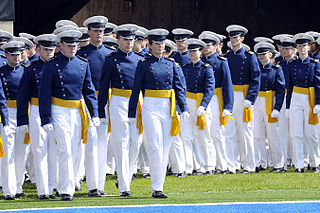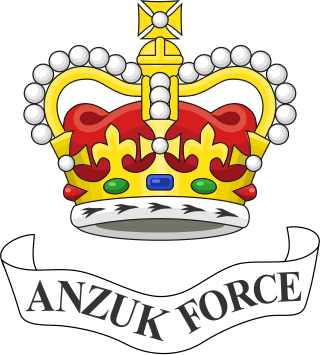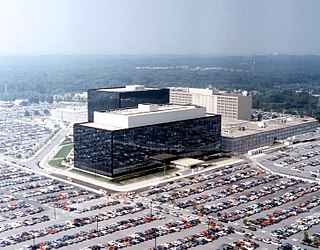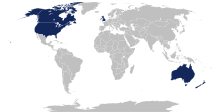The New Zealand Defence Force are the armed forces of New Zealand. The NZDF is responsible for the protection of the national security of New Zealand and her realm, promoting its interests, safeguarding peace and security, as well as supporting peacekeeping and humanitarian missions. It consists of three services: the Royal New Zealand Navy (RNZN), the New Zealand Army and the Royal New Zealand Air Force (RNZAF), as well as 'tri-service' components. The NZDF has a strength of 15,191 made up of 9,215 regular force personnel, 3,030 reserve force personnel and 2,946 civilian members. It is supported by the New Zealand Ministry of Defence (MOD) and is commanded by the Chief of Defence Force (CDF).

Australian Signals Directorate (ASD), formerly the Defence Signals Directorate (DSD) is the federal statutory agency in the Australian Government responsible for foreign signals intelligence, support to military operations, cyber warfare, and information security. ASD is part of the Australian Intelligence Community. ASD's role within UKUSA Agreement is to monitor signals intelligence ("SIGINIT") in South and East Asia. The ASD also houses the Australian Cyber Security Centre.
Corps is a term used for several different kinds of organization. A military innovation by Napoleon I, the formation was first named as such in 1805. The size of a corps varies greatly, but two to five divisions and anywhere from 40,000 to 80,000 are the numbers stated by the US Department of Defense.
Second lieutenant is a junior commissioned officer military rank in many armed forces, comparable to NATO OF-1 rank.

The Anglosphere is a group of English-speaking nations that share cultural or historical ties with England, and which today maintain close political, diplomatic and military co-operation. While the nations included in different sources vary, the Anglosphere is usually not considered to include all countries where English is an official language, so it is not synonymous with anglophone, though the nations that are commonly included were all once part of the British Empire.

A cadet is an officer trainee or candidate. The term is frequently used to refer to those training to become an officer in the military, often a person who is a junior trainee. Its meaning may vary between countries which can include youths in voluntary youth organisations.

The United Kingdom – United States of America Agreement is a multilateral agreement for cooperation in signals intelligence between Australia, Canada, New Zealand, the United Kingdom, and the United States. The alliance of intelligence operations is also known as the Five Eyes. In classification markings this is abbreviated as FVEY, with the individual countries being abbreviated as AUS, CAN, NZL, GBR, and USA, respectively.

Joint Terminal Attack Controller (JTAC) is the term used in the United States Armed Forces and some other military forces for a qualified service member who directs the action of military aircraft engaged in close air support and other offensive air operations from a forward position. The term that is used in most other countries, as well as previously in the U.S. and in the relevant NATO standard, is Forward Air Controller. The term became effective in the U.S. on September 3, 2003 with the publishing of Joint Publication (JP) 3-09.3 Close Air Support.
The Combined Communications-Electronics Board (CCEB) is a five-nation joint military communications-electronics (C-E) organisation whose mission is the coordination of any military C-E matter that is referred to it by a member nation. The member nations of the CCEB are Australia, Canada, New Zealand, the United Kingdom and the United States. The CCEB is the Sponsoring Authority for all Allied Communications Publications (ACPs). ACPs are raised and issued under common agreement between the member nations. The CCEB Board consists of a senior Command, Control, Communications and Computer (C4) representative from each of the member nations.

ANZUK was a tripartite force formed by Australia, New Zealand and the United Kingdom to defend the Asian Pacific region after the United Kingdom withdrew forces from the east of Suez in the early 1970s. The ANZUK force was formed in Singapore on 1 November 1971 under Rear Admiral David Wells and disbanded on 31 January 1974.

The Five Eyes (FVEY) is an intelligence alliance comprising Australia, Canada, New Zealand, the United Kingdom, and the United States. These countries are parties to the multilateral UKUSA Agreement, a treaty for joint cooperation in signals intelligence. Informally, Five Eyes can also refer to the group of intelligence agencies by these countries.

Command and control is a "set of organizational and technical attributes and processes ... [that] employs human, physical, and information resources to solve problems and accomplish missions" to achieve the goals of an organization or enterprise, according to a 2015 definition by military scientists Marius Vassiliou, David S. Alberts, and Jonathan R. Agre. The term often refers to a military system.

The Combined Space Operations Center (CSpOC) is a U.S.–led multinational space operations center that provides command and control of space forces for United States Space Command's Combined Force Space Component Command. The CSpOC is located at Vandenberg Space Force Base.
Signals intelligence by alliances, nations and industries comprises signals intelligence (SIGINT) gathering activities by national and non-national entities; these entities are commonly responsible for communications security (COMSEC) as well.

Canada–New Zealand relations are the international relations between Canada and New Zealand. Canada and New Zealand have a longstanding relationship that has been fostered by both countries' shared history and culture, and links between residents of both countries. The two countries are former British Dominions and have a common head of state in King Charles III. Both nations are members of the Asia-Pacific Economic Cooperation, Cairns Group, Commonwealth of Nations, Five Eyes, OECD and the United Nations.

A blue beret is a blue-colored beret used by various military and other organizations, notably the United Nations peacekeepers who are sometimes referred to as the Blue Berets.
The Technical Cooperation Program (TTCP) is a long-standing international organisation concerned with cooperation on defence science and technology matters, including national security and civil defence. Its membership comprises Australia, Canada, New Zealand, the United Kingdom (UK) and the United States (US).
Train Advise Assist Command – East was a multinational military formation, part of NATO's Resolute Support Mission within Afghanistan. Until 2014 it was designated Regional Command East, part of the International Security Assistance Force (ISAF). The United States Army provided the force headquarters. The command headquarters was located in Laghman Province.
AUSCANNZUKUS is an abbreviation for the naval Command, Control, Communications and Computers (C4) interoperability organization involving the Anglosphere nations of Australia, Canada, New Zealand, the United Kingdom, and the United States. It is also used as security caveat in the UKUSA Community, where it is also known as "Five Eyes."
The Air Force Interoperability Council (AFIC), also known as the Air and Space Interoperability Council (ASIC), is an organisation tasked with enhancing coalition military aviation amongst the "Five Eyes" countries, which consist of Australia, Canada, New Zealand, the United Kingdom and United States. AFIC has a permanent management committee based in Washington DC.











